The final dog days of August are upon us and we continue to circle the same worries: The Ukraine, the Gaza Strip, Iraq/Syria/ISIS, when the ECB will enact QE and when the FOMC will raise interest rates. But, while many wring their hands and rack their brains, the financial markets have other ideas. Like brand new highs.

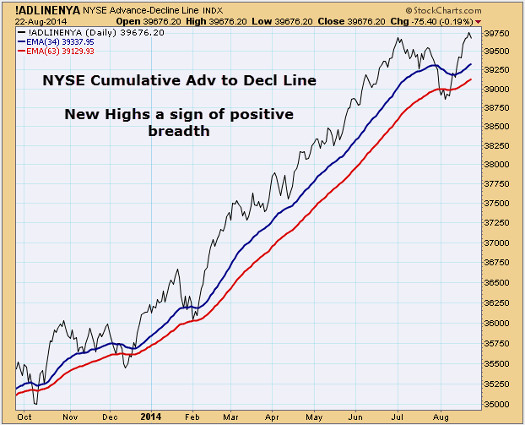
The long awaited Jackson Hole meeting was last week. Nothing completely new came to light, but some thoughts may have been adjusted slightly while the economists fished in the rain.
Fed Chair Yellen once again reiterated her view that significant slack remains in the U.S. labor market. While some regional Fed Presidents have noted over the past few
months their own belief that the economy is nearing full employment and that inflationary pressures could begin to rise above the Fed’s target, Yellen has remained undeterred in her view. Yellen also noted that the Fed remains focused on providing transparent guidance to markets on the path of monetary policy. Overall, the July 29-30 meeting minutes and Yellen’s comments from Jackson Hole continue to strike a dovish tone
Interesting to keep in mind. Big asset managers are betting on rate hikes sooner than Wall Street economists and strategists.
Big Wall Street hedge funds and money managers see an increasing probability that the Federal Reserve will raise short-term interest rates before the end of June next year. The survey conducted before the Fed’s July policy meeting showed 41% expected the Fed to start raising rates before the end of June 2015. That was up notably from 31% before the Fed’s June policy meeting and up from 25% at the beginning of the year. It’s striking that the money managers expect the Fed to be more aggressive than Wall Street banks and brokers, the so-called “sell side” of finance. A separate New York Fed survey of primary dealers – which are the big banks and brokers that trade securities with the Fed – showed 37% in July expected the Fed to start raising rates before the middle of 2015, up from 32% in June and 29% in January
Putting this summer’s worries aside, it was business as usual in the Health Care industry as a global Pharma company will pay up to get a top Biotech portfolio.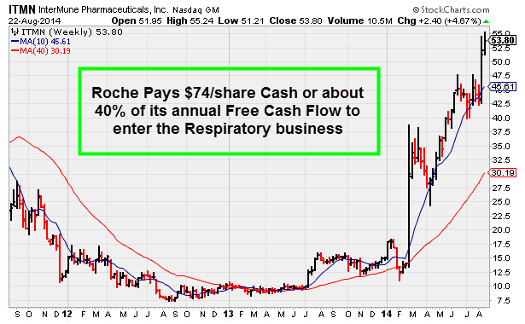
Roche GS (SIX:ROG) has agreed to buy InterMune Inc (NASDAQ:ITMN), the U.S. biotech company, for $8.3bn in the latest example of the feverish deal activity sweeping the pharmaceuticals sector.
The all-cash transaction – Roche’s biggest acquisition in five years – will give the Swiss group access to InterMune’s new medicine for a previously untreatable lung disease, highlighting the push by big pharma into so-called orphan drugs for rare or incurable conditions. The agreed deal is Roche’s biggest since its $47bn takeover of Genentech, another U.S. biotech company, in 2009 and marks its fourth acquisition this year as the group responds to investor pressure to put more of its cash to use. The $74-a-share offer represents a 63 per cent premium over InterMune’s share price before takeover speculation arose in mid-August, highlighting the hefty valuations being attracted by target companies as drugmakers compete for assets
And corporations continue to look to be more competitive and more efficient with their capital as Burger King tries to buy Tim Hortons and move its tax base to Canada.
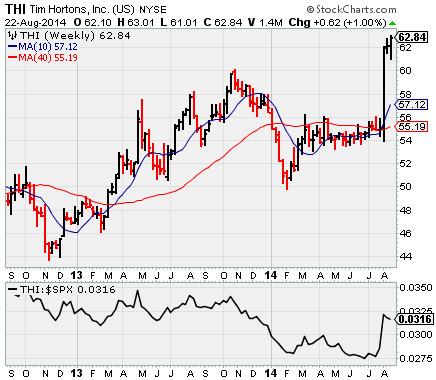
Burger King Worldwide Inc (NYSE:BKW) is in talks to buy Canadian coffee-and-doughnut chain Tim Hortons Inc., a deal that would be structured as a so-called tax inversion and move the hamburger seller’s base to Canada, according to people familiar with the matter. The two sides are working on a deal that would create a new holding company, one of the people said, adding that the takeover would create the third-largest quick-service restaurant provider in the world. One of the people said a deal between the two companies could be struck soon, though additional details on timing couldn’t be learned. Together the restaurant companies have a market value of about $18 billion. By moving to a lower-tax jurisdiction, inversion deals enable companies to save money on foreign earnings and cash stowed abroad, and in some cases lower their overall corporate rate.
Remember when Junk Bonds fell 5% in July due to illiquidity on the trading desks and the Long Term Buyers came in and took advantage of the lower prices?
U.S. high-yield bond funds recorded the biggest weekly inflow of 2014 as investors returned to the riskiest corporate debt following an unprecedented withdrawal at the start of August. Mutual funds and exchange-traded funds that buy junk bonds attracted $2.2 billion in the week ended Aug. 20, according to data provider Lipper. That’s the second straight week of inflows after investors pulled $7.1 billion in the five days ended Aug. 6, extending redemptions to as much as $12.6 billion over a four-week period. Demand is soaring for the debt as buyers purchase bonds with yields that reached the highest in more than eight months, banking on the Federal Reserve to keep suppressing interest-rate targets it has held near zero since 2008.
Meanwhile, as Long Term Yields remain at lows and spreads tight, Corporations are aiming for record issuance.
U.S. corporate-bond issuance is hurtling toward a record for the third consecutive year, as companies take advantage of a surprising interest-rate decline to stock up on cash. Companies around the globe have sold about $994.9 billion of bonds in the U.S. this year as of Thursday morning, according to data provider Dealogic, which has figures dating back to 1995. That is up more than 4% from a year ago, with sales on pace to cross the $1 trillion mark at the fastest clip on record. A $4.5 billion sale Thursday from Bank of America Corp. put the total closer to that milestone. Investors and analysts say companies are raising funds partly with an eye to investing in fresh projects as the U.S. economy gains pace, a move that can further help along economic growth. Acquisitions have about doubled in the U.S. from last year to a recent $1.1 trillion, and U.S. bond sales earmarked for capital spending—purchases or upgrades of long-lived assets such as plant and equipment—have risen 90% from a year earlier to $40 billion, Dealogic said.
But while Long Term Yields are trending lower YTD, the opposite is happening with Short Term Yields.
If you know an Architect, make them buy the next round.
The last three months have shown steadily increasing demand for design services and the Architecture Billings Index (ABI) is now at its highest level since 2007. As a leading economic indicator of construction activity, the ABI reflects the approximate nine to twelve month lead time between architecture billings and construction spending. The American Institute of Architects (AIA) reported the July ABI score was 55.8, up noticeably from a mark of 53.5 in June. This score reflects an increase in design activity (any score above 50 indicates an increase in billings). The new projects inquiry index was 66.0, following a very strong mark of 66.4 the previous month.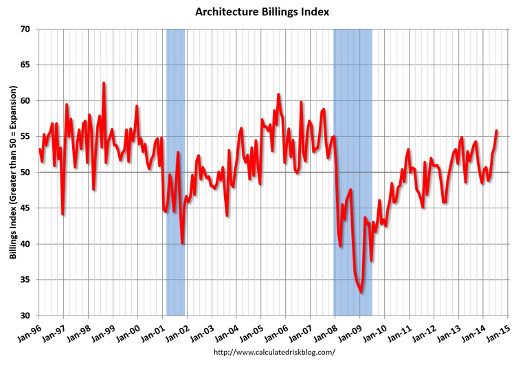
Commercial Real Estate demand has led Residential, but some interesting data points last week has given investors new thoughts on their Homebuilding exposures.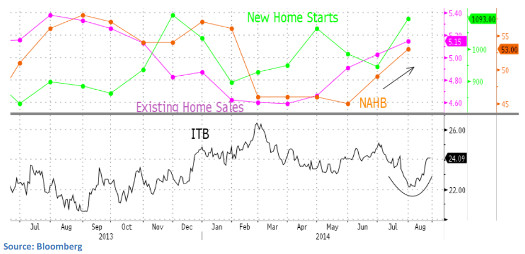
New residential builds aren’t the only area of excitement as the earnings of both Lowe’s and Home Depot generated plenty of after-market/remodel purchase excitement.
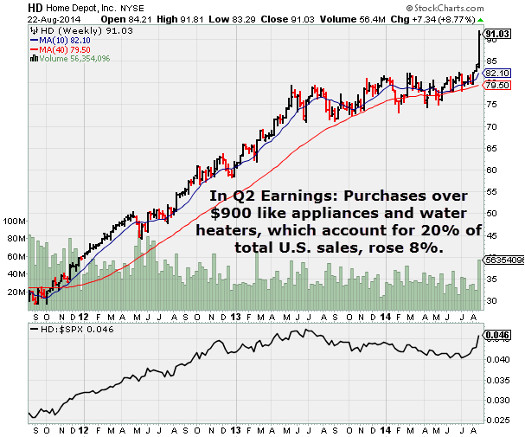
As we mentioned seven weeks ago, some interesting buying was occurring in the Consumer Discretionary space. At the time the Retail sector released earnings this month, most of those buyers were rewarded with very strong post earnings moves.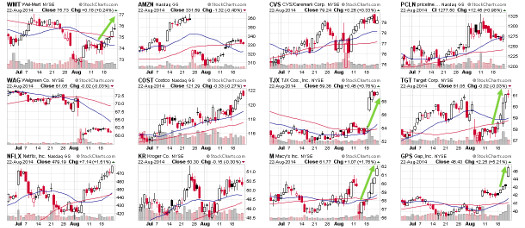
And my nomination for the Wild and Crazy Sector of the Month is.
@HistoryInPics: Steve Martin, 1977
(By Norman Seeff)
.Industrials. This group was hit hardest of all sectors in July as geopolitical issues hit both global growth estimates and worried airline stocks. But as growth worries have lessened and oil prices have continued to fall, the sector bounced hard off of its 200 day moving average.
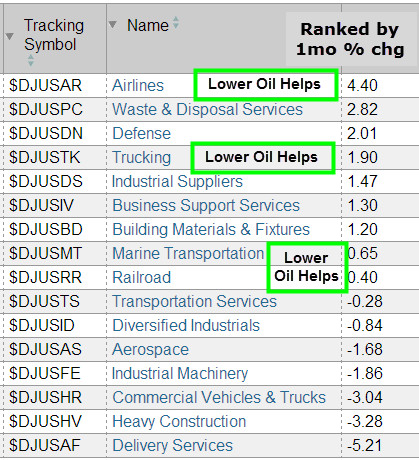
Google Inc (NASDAQ:GOOGL) turned 10 years old this week. At its IPO, it had a P/E Ratio of 130 which kept many away from the stock. It has risen tenfold since then.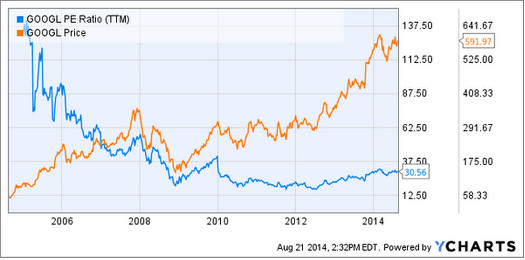
And with the market making all time new highs, the largest market cap in the market followed suit.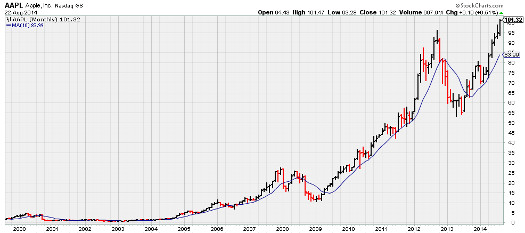
For the week, every sector gained, with Cyclicals leading the charge (Financials, Industrials & Consumer Discretionary).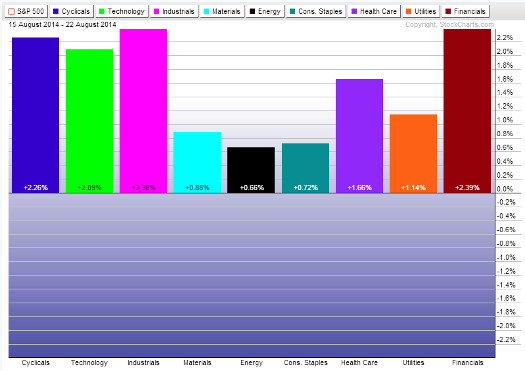
More broadly, the U.S. led a very broad-based move up. Gold, Commodities, & Fixed Income lagged.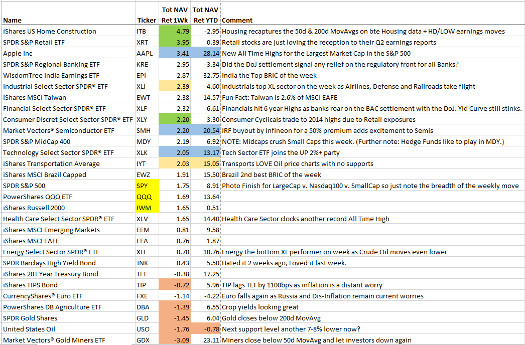
If you have a kid or friend looking for a new gig, have them run this list of great companies against a list of the cities that they would like to live in. Nothing better than working for a great company.
Want to work for a company where employees are satisfied with the culture and values? Glassdoor has announced its report of the Top 25 Companies for Culture & Values, based on workplace insights shared by the people who know companies best — the employees. The following companies stand out for high culture & values ratings and insightful reviews.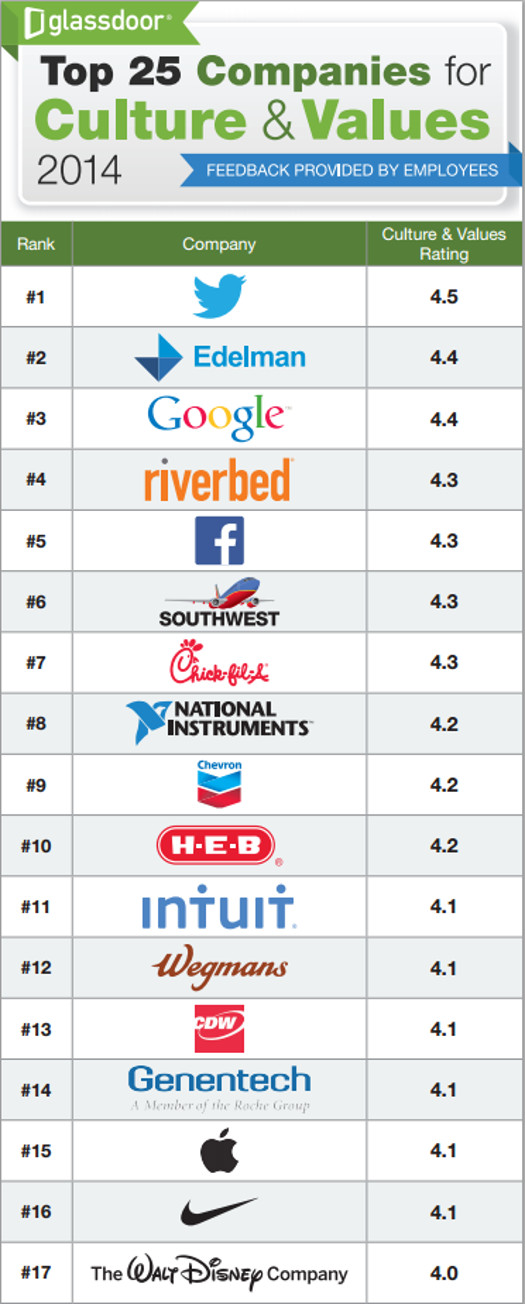
Finally, as school starts, here is one to show the kids the next time they tell you that they can’t do something.
